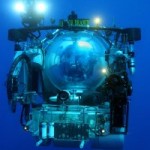 Photosynthesis, that is. Get your mind out of the gutter! This admittedly sexy anaerobic green sulfur bacterium is capable of photosynthetic growth in the dark ocean depths. It’s able to use geothermal radiation from black smoker hydrothermal vents as a light source, making it the only photosynthetic organism known to use a light source other than sunlight.
Photosynthesis, that is. Get your mind out of the gutter! This admittedly sexy anaerobic green sulfur bacterium is capable of photosynthetic growth in the dark ocean depths. It’s able to use geothermal radiation from black smoker hydrothermal vents as a light source, making it the only photosynthetic organism known to use a light source other than sunlight.
Just as hot electric-stove elements radiate light, black smokers glow dimly as 400 degrees C fluid emerges. Most of the glow lies in the infrared spectrum, which the microbes can’t absorb, but part of the light reaches the edge of the visible spectrum. The microbes appear to eke out a living from that light, which the researchers can see only through night goggles.
“It expands our vision of possible environments where you could have photosynthesis,” says biochemist Robert Blankenship of Arizona State University in Tempe.
Apparently, telling these bacteria to ‘stick it where the sun don’t shine’ doesn’t have the same derogatory connotations typically implied.

Thermal image of ‘vent glow’ taken on the Juan de Fuca Ridge, credit John Delaney, University of Washington
See also Beatty et al. (2005) An obligately photosynthetic bacterial anaerobe from a deep-sea hydrothermal vent. PNAS 102(26): 9306-9310.
Image credit: Magnified image of green sulfur bacterium, credit Lars Juul






“the only photosynthetic organism known to use a light source other than sunlight”
My husband just read this post and told me I was mistaken…he pointed out that many marijuana plants (photosynthetic organisms) are grown indoors with artificial light. I consider this a technicality since the artificial light is doing its best to imitate sunlight, however, I concede that he has a point of sorts.
Funny, I don’t recall your husband being one of my college house mates ;^)
Thanks for the this post. I found this part of the linked article by Naila Moreira a fascinating area of inquiry:
I especially love the closing quote from Blankenship, “‘Where there’s light, there’s photosynthesis’ is the take-home lesson.”